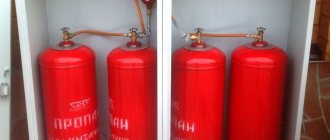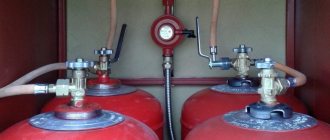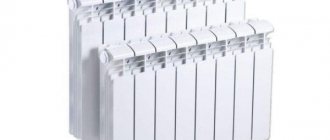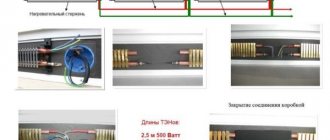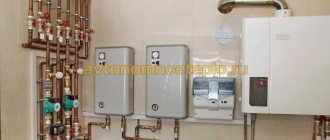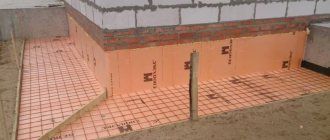Have you ever tried to detect a gas leak in the kitchen by smell? What if there is no smell or it is difficult to detect? Agree that those who understand the main differences between gas mixtures and know how to identify them feel more confident. It is important to know what liquefied gas is in cylinders and how it will behave if the integrity of the gas pipeline is violated. This is a security issue.
Each type of fuel has its own characteristics. Specific heat of combustion, color, smell, spontaneous combustion temperature - all these are signs by which we identify a substance. An important parameter is molar mass. The distribution of gas during a leak depends on this value: it will accumulate below, filling the basement, or, conversely, it will rise.
The ability to understand balloon mixtures is the key to proper operation and the absence of fatal errors during replacement and disposal. In addition, knowledge of the theory will help you make an informed choice when purchasing. And this is already half the battle.
Natural or liquefied - what's the difference?
When choosing a fuel source, the user may come across two concepts: natural gas and liquefied gas. The first, in most cases, is transmitted through urban backbone networks. Much less often it can be purchased in a compressed state in containers. The second is the traditional composition for propane and butane cylinders.
Characteristics of natural gas
The main component is methane . It accounts for almost no less than 70%.
The remaining parts are distributed among heavy hydrocarbons:
- propane;
- butane;
- ethane;
- pentane.
In addition, the composition includes hydrogen, nitrogen, carbon dioxide and a small amount of hydrogen sulfide. It is important to know that natural gas is odorless and colorless. Therefore, it is customary to enrich natural gas in cylinders with odorants - substances with a pungent odor.
You don't have to sniff to detect a leak. Due to its volatility, the compound instantly spreads indoors and quickly attracts attention.
If you feel an unpleasant odor, the first thing you need to do is open the windows in the room where the cylinder is located. Then go out and call the gas service. It is prohibited to check the concentration of the mixture in the air using a match or lighter.
The most common odorant is ethanethiol, which smells like rotten or rotten eggs. In large quantities this compound is toxic. In low concentrations, characteristic of the classic composition of a household gas mixture, it is absolutely harmless.
Advantages of liquefied gas
The liquefied gas is propane and butane, mixed in different proportions. Under high pressure, these carbons turn into liquid and noticeably decrease in volume. The reverse process is possible with increasing temperature - heating entails expansion of the substance. Therefore, cylinders for liquefied hydrocarbon gases are manufactured strictly in accordance with GOST standards and are filled no more than 85%.
The undeniable advantage of propane-butane gas is its lightness. A cylinder filled with such a mixture will be several times lighter than a similar container with methane.
Other advantages:
- environmental Safety;
- a strong specific odor is a useful indicator of leakage;
- low cost.
A properly configured stove connected to a cylinder with hydrocarbon gas will operate without soot and produce even streams of burning fuel.
Necessary equipment for heating with liquefied gas
If you decide to heat your house with liquefied bottled gas, then in addition to the basic equipment described below, you will need the following parts:
Comb or tee - necessary for combining several cylinders;
Fittings – threaded or quick-release;
Pressure gauges for pressure control;
High pressure taps and hoses;
Heating of cylinders and reducer;
Switches between groups of cylinders;
Valves – check and relief valves, emergency shut-off valves.
Heating boiler
When using LPG, the heating boiler is a conventional one designed for burning gas (gas heating boiler). It can be a wall-mounted gas boiler or one mounted on the floor. The only thing when purchasing is to choose the most economical option, for example, a condenser boiler, this will reduce the consumption of such expensive fuel.
However, a standard gas boiler needs a little modification to accommodate operating conditions from bottled gas. This applies to burners - they are replaced with special ones, and as a rule, they come complete with the heating boiler.
Winter and summer mixtures
Since only one 5-liter cylinder is allowed in residential premises, larger containers are installed outside the home. Accordingly, the climatic conditions during use can be anything. Taking this factor into account, gas compositions are created for the warm and cold seasons, which are described in more detail here.
What is the difference between the seasonal versions?
Inside the cylinder, liquefied gas is in two states of aggregation: liquid and gaseous. The intensity of filling the gas duct with the gaseous fraction directly depends on the temperature: in warm conditions the indicator is higher than at low temperatures.
The graph shows that mixing propane and butane allows you to balance the ability of these compounds to evaporate. This is the basis of the principle of creating “climate” compositions
Correction of this situation is carried out by changing the proportions of propane and butane. The first is capable of evaporating at 42 degrees below zero. The second loses this ability immediately after crossing the zero mark.
Therefore, in winter versions, the volume of propane increases. In summer, on the contrary, it decreases. This approach makes it possible to reduce the cost of summer versions due to cheaper butane and ensure the efficiency of winter ones.
Calculation of proportions taking into account climate
When determining the recommended proportions, the central part of Russia was taken as the starting point. The minimum propane content for the winter version is limited to 70%. In the summer version, 50 percent content is acceptable.
The abbreviation SPBT means a mixture of propane and technical butane - the proportions are selected according to needs. BT – technical butane contains 60% butane. PT – technical propane – minimum 75% propane
The composition for other regions is carried out taking into account the distance from the middle zone and climatic conditions. This must be done by specialists from licensed organizations.
Universal option for any temperature
Correct functioning of portable gas systems over a wide temperature range is typical for the combination of propane, isobutane and butane. Having different combustion temperatures, these substances made the complex composition as versatile as possible.
Painting and marking of gas cylinders
Surprisingly, the world has not yet come to a unified system for marking gas cylinders. Therefore, when choosing a fuel source abroad, it is necessary to study local regulations. In Russia, all containers with gas mixtures used for cooking on the stove have a white transverse inscription on a plain red background.
Propane is never used to fill cylinders in its pure form. However, the inscription is made according to the predominant substance. This rule applies to other mixtures as well.
All other information is on a metal plate - a kind of product passport. This is the service life, serial number, empty container weight, date of manufacture and next certification, manufacturer’s trademark, test pressure.
Coloring and marking standards are the same for methane and propane-butane mixtures - only red cylinders with white lettering are suitable for use in the kitchen. Other colors may mean that the container is filled with nitrogen, argon, ammonia, helium, or freon.
Manufacturers
The main countries producing liquefied gas are, according to 2009 data:
- Qatar - the volume reaches almost 50 billion m³;
- Malaysia and Indonesia - 29.5 and 25 billion cubic meters, respectively;
- Australia and Algeria – 24 and 21 billion m³.
Japan ranks first among LNG importers. Gas is also purchased by: Spain, USA, France, India.
There are also 2 operating factories in Russia. One of them is the Sakhalin-2 project launched in 2009. The controlling stake is owned by Gazprom. The co-owners are: 27.5% Shell, 12.5 Mitsui, 10% Mitsubishi. At the end of 2015, annual production reached 10.8 million tons, which is 1.2 million tons more than the designed capacity. Unfortunately, due to falling prices on the world market, exports have decreased noticeably in recent years.
Another significant player in Russia is Novatek (Yamal-LNG).
The Americans did not stand aside either: they commissioned 5 LNG export terminals, the total capacity of which is 57.8 billion tons/year. It is clear why there has been a fierce confrontation between these countries for many years.
How to detect a leak?
The difference between methane and propane-butane mixture leaks is the smell. But in both cases, the stench will make itself felt first.
To detect the penetration of both trains into the airspace, 4 methods are suitable:
- Definition by hand. Household gases are colder than air. By running your hand over the flange connections and joints of gas pipeline elements, you can easily feel the emanating chill.
- Using soap solution . Bubbles that appear on the treated surface indicate a problem.
- Installation of a stationary sensor . Models that provide not only a digital signal in the form of instrument readings, but also an audio signal are preferred.
- Measurement with a portable device.
The method for measuring the concentration of a harmful compound in the air using portable sensors depends on the composition of the gas in household cylinders installed in the kitchen or outside the home.
A red lamp indicates possible danger. The lighting of the green lamp is a confirmation of well-being. If in doubt, it is worth repeating measurements near possible leaks: at joints and connections
When measuring propane/butane leakage, the device must be installed at the lowest point in the room. The heavy mixture will primarily fill the space near the floor.
The situation with methane is the opposite - this gas is two times lighter than air. Therefore, as it evaporates, it will move upward. Accordingly, measurements will have to be taken from the ceiling.
How to calculate the fullness of a cylinder?
The filling of the cylinder with the mixture can be easily determined by its weight. To do this, you need to know the weight of the empty container and the weight of the gas. Both values are always indicated on the metal passport of the product. This could be a rectangular plate or a disc around the valve. The sum of these two values is equal to the mass of a fully filled cylinder. A decrease in the amount indicates fuel consumption.
The weight of the mixture of butane and propane depends on the selected proportion, since propane is a lighter gas. At zero temperature, one liter of a 1:1 mixture will weigh 564 grams. The weight of one liter of methane under the same conditions will be equal to 710 grams.
LNG production technology
Gas liquefaction occurs in several stages, in which it is compressed 5-12 times, cooled and transferred further.
At the first stage, it is necessary to remove water from natural gas in order to protect refrigeration equipment from its aggressive effects, as well as hydrogen, as well as helium, sulfur compounds, nitrogen and other impurities, for which deep absorption purification is used, passing the mixture through a molecular sieve.
This is followed by the second stage, which consists in removing heavy hydrocarbons from the mixture. Fractionation leaves a gas containing only methane and ethane (or butane and propane). The resulting fraction contains less than 5% impurities.
At the last stage of the process, the liquefaction of the cooled gas occurs. The process is quite energy-intensive: up to 25% of the total amount is required.
Modern production uses 2 technological processes:
- compression, i.e. condensation taking place at constant pressure. The disadvantage is the high energy consumption, which is why the method is considered ineffective;
- method based on heat exchange processes, i.e. refrigeration, which involves the use of a cooler, as well as turbo-expander, also called throttling. It allows the rapid expansion of gas to obtain the desired temperature. The disadvantages of the method include the low liquefaction coefficient - at the level of 4%, which requires repeated distillation. It is possible to increase it to 14% by using a compressor-expander circuit.
The use of thermodynamic schemes makes it possible to increase efficiency to 100%:
- application of a cascade boiling point reduction cycle. Refrigerants at different stages are: propane, nitrogen, ethane, methane, purified or sea water, air;
- a cycle that simultaneously uses 2 refrigerants – ethane and methane;
- use of expansion cycles in liquefaction technology.
Several such technologies are leading on the modern market:
- up to 82% of the total market belongs to AP-C3MR™, AP-SMR™ and AP-X™ technologies, which are used to produce significant volumes of LNG;
- Optimized Cascade, developed by ConocoPhillips;
- in production (for internal use) compact GTL units are used;
- to obtain LNG involved in the production of gas motor fuel (gas motor fuel), local installations are widely used;
- FLNG – the use of sea tankers and ships with gas liquefaction units. This allows you to have access to fields that are inaccessible to gas pipeline infrastructure;
- the use of floating LNG platforms (for example, the one being built in a 25-kilometer zone in Australia by Shell).
Reasons for the prevalence of propane mixtures
Compositions of propane and butane are much more often used as raw materials for filling household gas cylinders.
The reasons are simple:
- Propane is easier to liquefy. To influence it, a pressure of 16 atmospheres is enough. Methane will only become liquid after exposure to 150 atmospheres.
- Inexpensive cost of producing liquefied gas in comparison with a methane mixture.
- Less durable cylinders, which has a positive effect on the price.
- Safety of use.
Using a container with an internal pressure of 16 atmospheres is much safer. And this is an important selection criterion.
Ecological fuel
Liquefied gas has a fairly high octane number and is distinguished by high energy indicators, which allows it to be used for refueling cars. Without harming the environment, the use of this fuel reduces oil consumption and engine wear. Its price is lower than the cost of gasoline. In addition, liquefied gases are safe, and refueling is carried out at specialized gas stations. This explains why it is considered a more economical fuel than gasoline.
Disposal of gas cylinders
Compliance with the rules of safe disposal is mandatory for gas cylinders with any composition. They must be handed over to specialized collection/exchange points. Despite the fact that propane-butane gas is contained in a container at a lower pressure than methane gas, the possibility of an explosion remains. The reason for this is the high residual pressure of propane.
Some companies offer profitable exchanges of old containers for new ones or make significant discounts on the purchase of new cylinders when returning used containers
The main motives for opening old containers on your own are the use of empty containers for household purposes and scrap metal. Experts advise abandoning such ideas or using the help of professionals. The main thing is to remember that a solid cylinder is never completely free of the gas mixture.
An excellent solution is to hand over the cylinder to a private service company. As a rule, their prices significantly exceed the benefits of scrapping the container. An additional bonus is pickup, when representatives of the organization go to pick up the equipment at the specified address.
Advantages
- Convenience of energy storage (due to the high density of liquefied gas), delivery and consumption. The cryogenic non-toxic liquid is stored at minus 162 degrees Celsius. For large volumes, above-ground containers are used, where it is under atmospheric pressure;
- Intercontinental transportation, for which gas tankers, tank trucks or railway tanks are used;
- Opens up the possibility of gasification of objects located at considerable distances from gas mains. There is no need to build expensive pipelines.
Conclusions and useful video on the topic
In order not to make a mistake when choosing, you can focus on the color of the container. To connect to a gas stove, use red cylinders with white inscription:
The most popular composition used to fill household cylinders is a mixture of propane and butane. Correctly selected proportions allow you to effectively use the physical properties of both substances.
Please note that a cylinder with an inscription that does not meet the requirements must be removed from service. Any attempts to paint over or change the name are a violation of the rules.
Maybe you have useful experience using cylinders for a gas stove, are you well versed in the composition, or have you ever managed to notice a leak in time? Write about it in the comments. Your experience may be invaluable to other users.
Pros and cons of bottled gas in the country
Among the advantages, we can immediately note the convenience and speed of boiling. The pan boils much faster than on an electric stove. Due to the fact that the electric stove was removed from the table, the load on the wiring in the house was reduced. This is important for us, because we heat the house with electric convectors. In terms of money, using a gas stove is slightly more profitable than an electric stove. Hand on heart, we can say that the benefit is not great at all. When we come to the dacha in cold weather, we light the gas together with the electric convector and put the kettle on to boil. The room heats up in this mode in literally 30-40 minutes, even in winter.
It is worth considering that gas from summer filling freezes in winter and practically does not burn if the tank is not full. If the cylinder is standing in the cold, it is better to use winter gas.
The disadvantages include the fact that it is a gas, and you need to keep an eye on it. The second disadvantage is that the cylinders still need to be changed. They have this peculiarity - they always end at the wrong time. And there is no way to control the remainder. In addition, the mass and quality of the refill depends only on the conscience of those who supply and refill this gas. At our dachas, no one changes or refills gas cylinders and you have to go to the city specifically. Whatever is always convenient. Our gas quality is quite good. Many people on the Internet write about the disgusting quality and smoking stoves. The third disadvantage is the need for a suitable place for the cylinder, and it takes up quite a lot of space.
But still, for us, all the disadvantages are insignificant compared to the ease of use. The cost of filling a gas cylinder in 2022 in the summer was about 600 rubles. One cylinder is enough for almost a full season for a family of 2-3 people. But we often travel to the city. If you live in the country all the time, then either the cylinder needs to be larger or changed more often. And finally, a little advice. If you change the cylinder when it is frosty and the refill is winter, then it will last for a longer period of time. And it burns much better in the cold and does not freeze compared to summer gas station.


